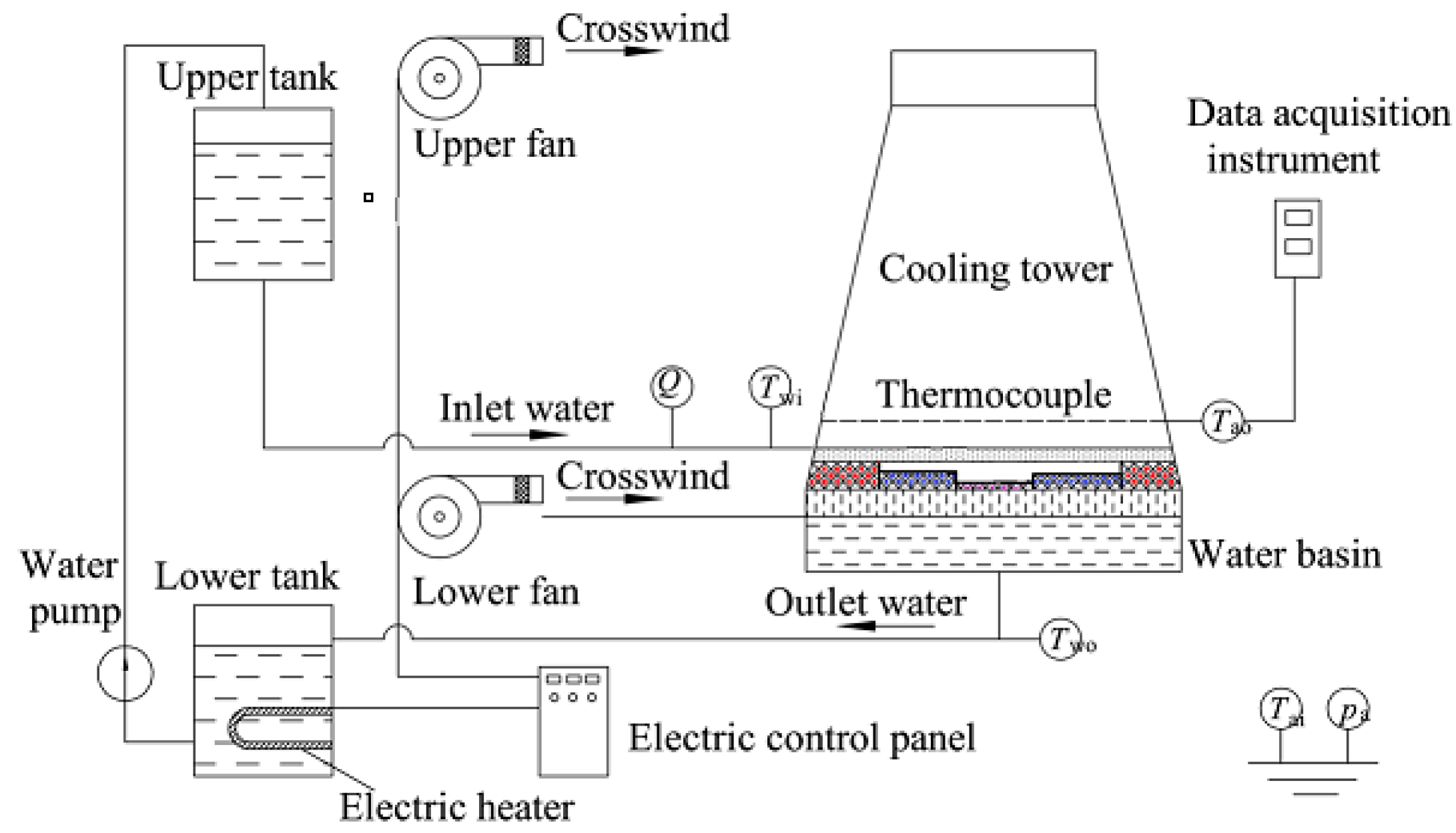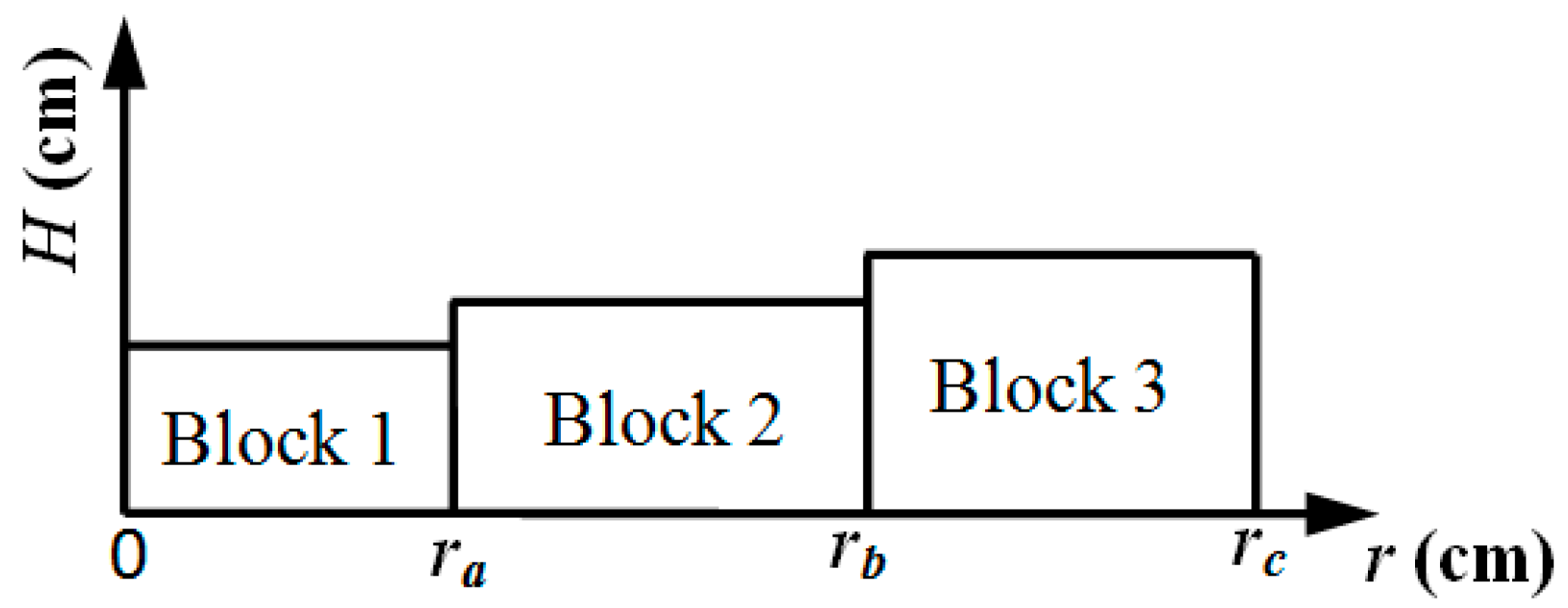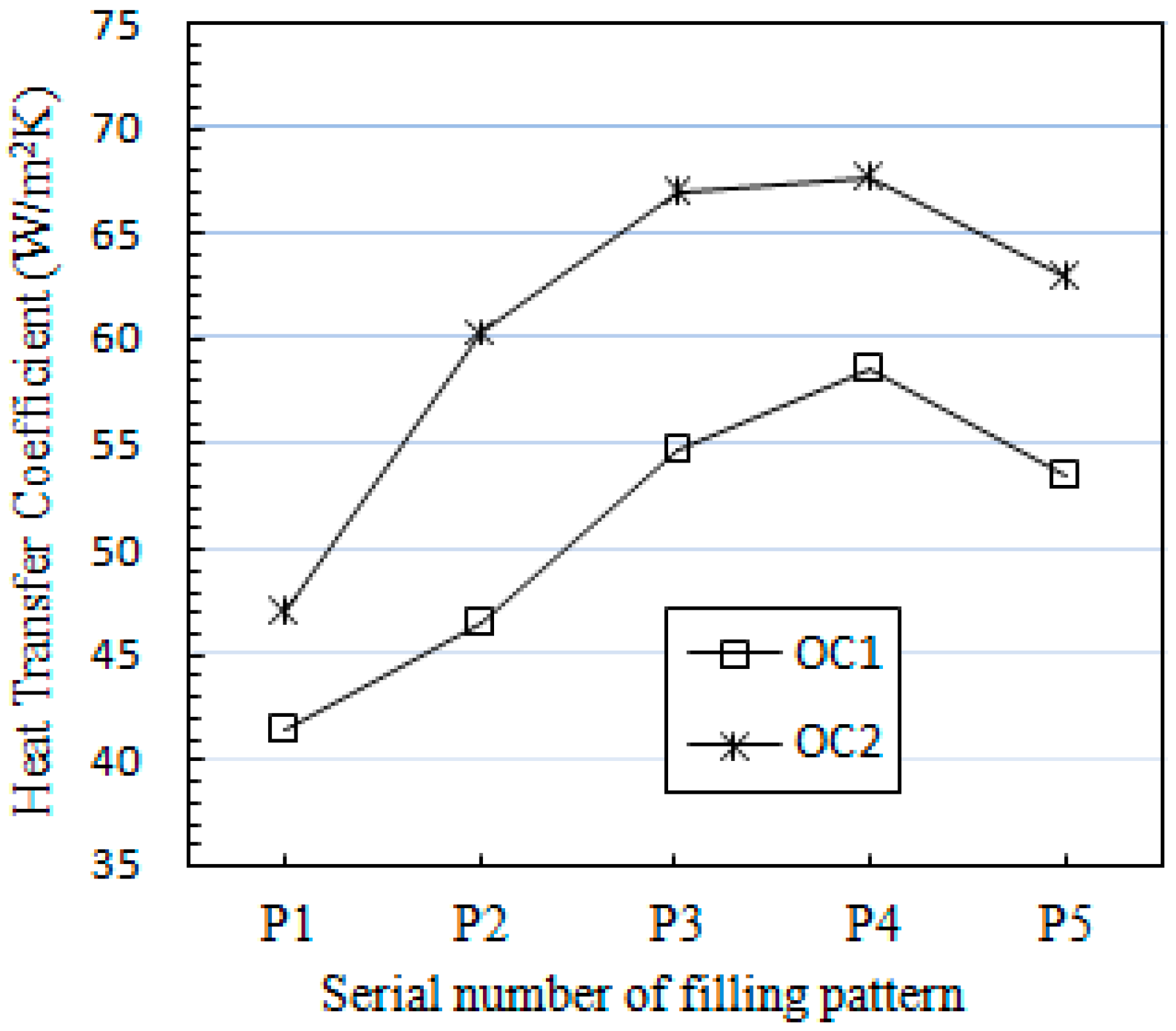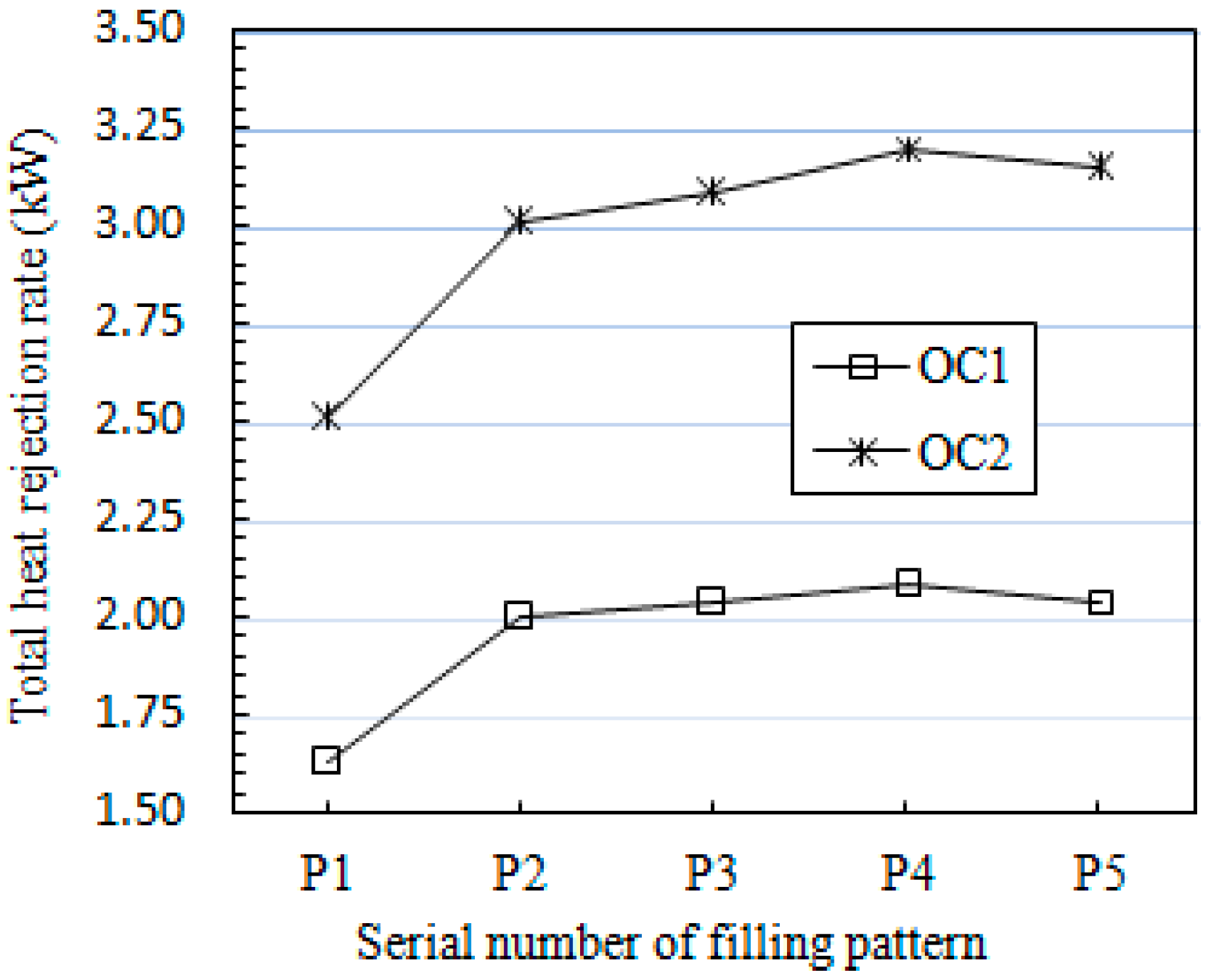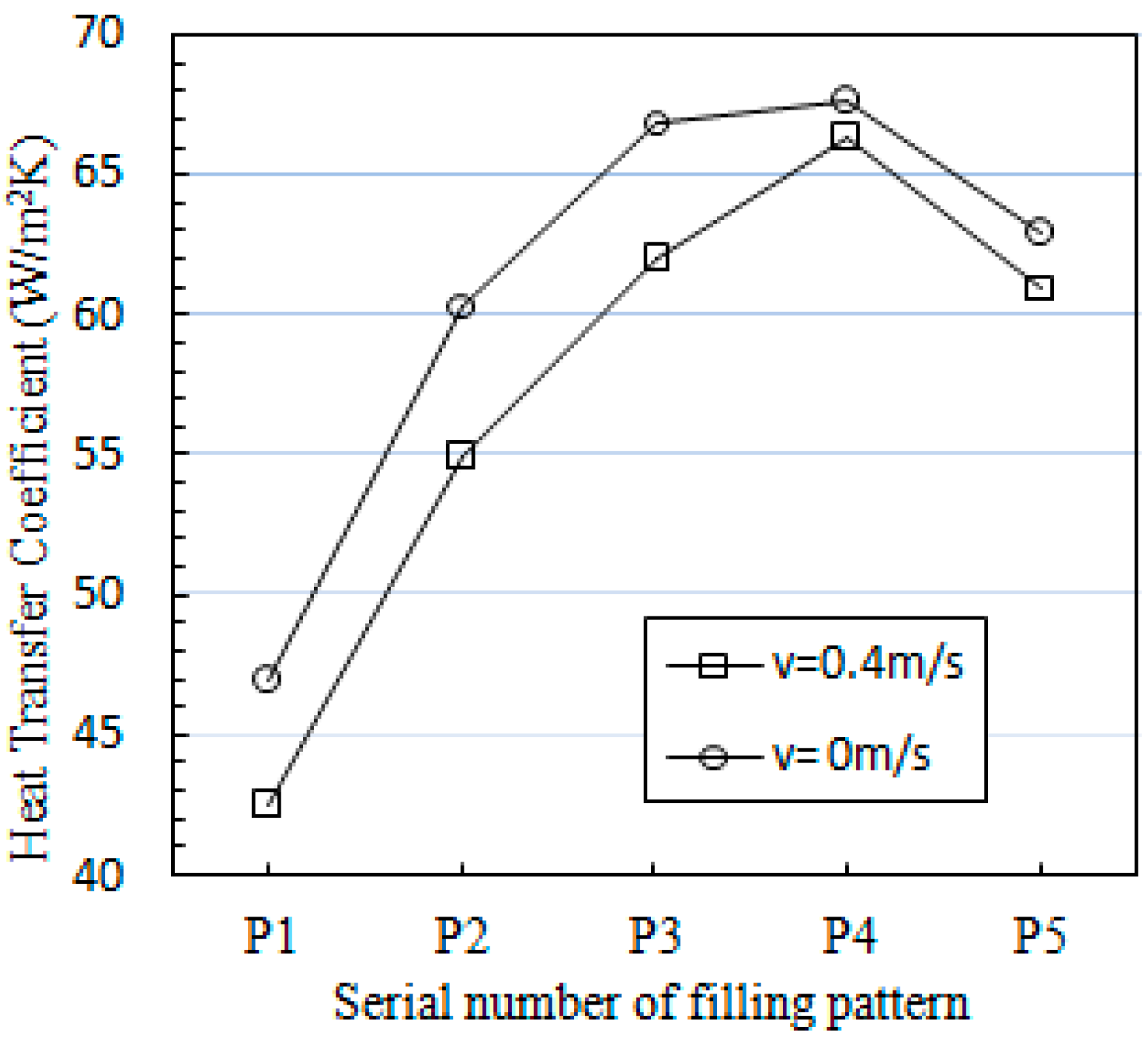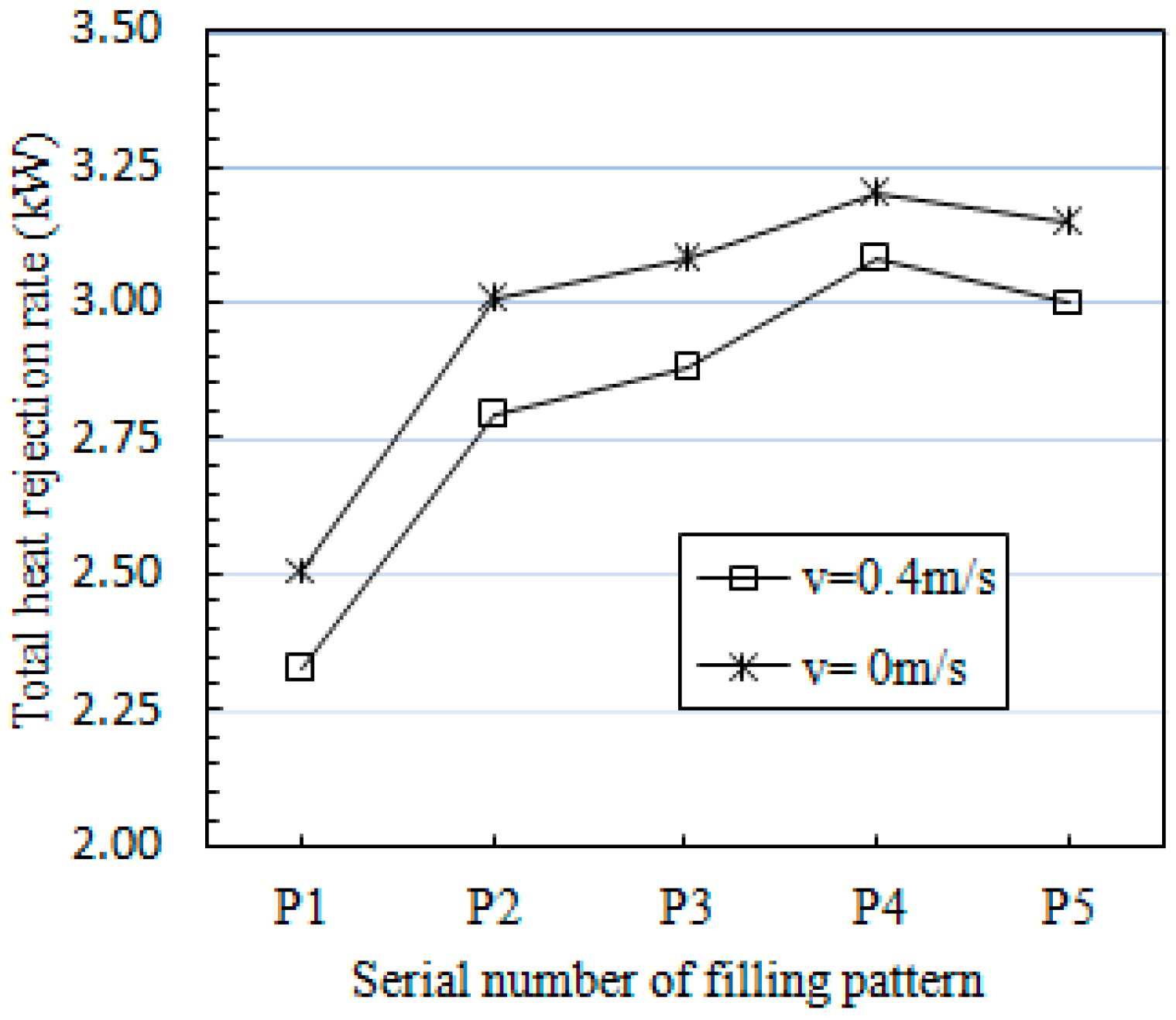1. Introduction
Cooling towers are widely used to extract heat from warm water to the atmosphere in most power stations, refrigeration, and air conditioning industries [
1,
2]. They can be classified by means of contacting mode into dry [
3,
4] and wet types. Moreover, they can also be classified by the driving force of air stream as mechanical-draft [
5,
6] and natural-draft types. As one of the main types, the natural-draft wet cooling towers play an important role to cool the circulating water from the condenser in thermal power plants or some inland nuclear power plants, and the cooling towers can directly affect the total power generation capacity [
7]. Based on prior studies, 70% of heat extraction capacity occurs in the filling zone [
8]. Therefore, it is extremely necessary to study the thermal performance of the filling zone.
Many researchers have focused on the thermal performance of fillings for wet cooling towers, and early research traces back to the 1940s [
9,
10,
11]. Briefly, the research regarding fillings can be divided into three aspects, which are theoretical mathematical model research [
12,
13,
14,
15], lab-based model experiments [
16,
17,
18,
19], and numerical computation [
20,
21,
22,
23].
However, the prior studies failed to discuss the height difference of the filling layout, and regarded fillings as the same height in different radii inside the tower. Actually, a uniform layout fillings pattern is obviously unreasonable due to the non-uniform air dynamic field inside the tower. Thus, studies regarding the layout pattern of fillings are extremely crucial to further energy-saving research for wet cooling towers. Gao et al. [
24] performed a thermal-state model experiment to investigate the influence of filling layout pattern on thermal performance of a wet cooling tower, including the cooling temperature difference, cooling efficiency, Merkel number, Lewis number, and ratio of evaporative heat rejection, and obtained one kind of optimal non-uniform pattern. However, Gao et al. did not research the change rules of heat transfer coefficient and total heat rejection of circulating water—which are extremely significant for analysis of the thermal performance of wet cooling towers—and furthermore, their study did not consider crosswind conditions.
Consequently, in this paper, studies of filling layout patterns inside wet cooling towers are conducted via a basic thermal-state model experiment to reveal the change rules of heat transfer coefficient and total heat rejection of circulating water under windless and typical crosswind conditions, with the further aim of determining the influence of filling layout patterns on the thermal performance of wet cooling towers under a typical crosswind speed value of 0.4 m/s.
2. Experimental Study Design
2.1. Experimental Setup and Operating Conditions
The experimental setup is displayed via the schematic diagram depicted in
Figure 1.
The model tower adopted in this experiment is designed to simulate a typical wet cooling tower in large-scale power plants in terms of the geometry similarity, Froude number similarity, and wind velocity scale similarity, which are detailed in [
25,
26,
27,
28]. Additionally, the relevant scale measure of model to prototype tower is 1:100, and the details of the primary measurement setup and instruments are listed in
Table 1.
During the whole experiment, the circulating water inlet temperatures were 50 °C, 55 °C, and 60 °C. The circulating water rates were 4 L/min, 6 L/min, and 8 L/min, and the crosswind speed was chosen to be 0.4 m/s, which was monitored by the lower fan marked in
Figure 1. Additionally, five types of filling layout patterns [
24] used in this study are detailed in
Section 2.2.
2.2. The Determination of Typical Crosswind Speed
According to the research works [
25,
26,
27,
28] from Group Gao, the performance parameters of wet cooling towers—such as cooling efficiency, cooling temperature difference, Merkel number, Lewis number, heat transfer coefficient, etc.—showed a shifting point when the experimental crosswind speed reached 0.4 m/s, indicating that this wind speed is a special crosswind working condition. Therefore, in this paper, the typical crosswind speed was chosen to be 0.4 m/s during the experiment, and the corresponding actual field crosswind speed was 4 m/s based on the similarity criterion.
2.3. Filling Layout Patterns inside the Model Tower
In this experiment, five kinds of layout patterns were chosen to study the change rules of two performance parameters for a wet cooling tower: heat transfer coefficient and total heat rejection of circulating water. The block plan is shown in
Figure 2, and the details of different layout patterns are pointed out in detail in
Table 2, where P1–P5 represent five pattern types. Additionally, the water is uniformly distributed using nozzle spray, the same distribution system in use in natural draft wet cooling towers.
2.4. Experimental Object
Based on the cooling temperature difference, cooling efficiency, Merkel number, Lewis number, and ratio of evaporative heat rejection, Gao et al. [
24] obtained the optimal non-uniform layout pattern for which the radius ratio of
ra/
rc is approximately 0.44 and
rb/
rc is around 0.71 (refer to
Figure 2 and
Table 2). Higher heat transfer coefficient and total heat rejection indicate stronger cooling performance. Thus, this study focused mainly on the change rules of the heat transfer coefficient and total heat rejection of circulating water under the different layout patterns, and on analyzing the effect of optimal non-uniform fillings on these two parameters under windless and 0.4 m/s crosswind conditions.
3. Experimental Results and Analysis
3.1. Influence of Filling Layout Patterns on Performance Parameters under Windless Conditions
Under the windless conditions, the relationship curves between heat transfer coefficient, total heat rejection of circulating water, and five kinds of layout patterns are shown in
Figure 3 and
Figure 4 for two different operating conditions, with the circulating water inlet temperature being 50 °C and 60 °C, and the circulating water rate being 6 L/min.
In this thermal-state model study, drift losses are slight and can be neglected, so the heat transfer coefficient
αv is defined by
In the formula above, is the specific heat of wet air at the outlet of the model tower (kJ/kg °C); G is the airflow rate (kg/s); and and represent the inlet and outlet air temperature of the model tower (°C). Additionally, is the average value of inlet and outlet circulating water temperature, and is the average value of and . Finally, V represents the exit area of fillings (m2).
Figure 3 describes the change rules of heat transfer coefficient under five kinds of layout patterns. The heat transfer coefficient under non-uniform fillings is obviously higher than that under the uniform pattern, and pattern P4 is the optimal non-uniform layout pattern. Experimental results demonstrate that—compared with the uniform layout pattern (P1)—the heat transfer coefficient in P4 pattern can increase by approximately 40%.
Figure 4 explains the change rules for total heat rejection of circulating water under five kinds of layout patterns. Almost the same rules as for heat transfer coefficient can be drawn from
Figure 4. This is because a larger total heat rejection indicates a stronger cooling performance. Obviously, the thermal performance is excellent under non-uniform patterns in terms of the total heat rejection of circulating water—especially with pattern P4. Additionally, the relative increase of the total heat rejection under pattern P4 was around 28%, compared with the uniform pattern P1.
Apparently, according to the heat transfer coefficient and total heat rejection of circulating water, the thermal performance of wet cooling towers under non-uniform fillings can be much higher than that of uniform filling patterns. Meanwhile, this study pointed out that under windless conditions, the heat transfer coefficient and total heat rejection of circulating water for the optimal non-uniform pattern (pattern P4) can enhance about by 40% and 28%, respectively, compared with the uniform pattern.
3.2. Influence of Filling Layout Patterns on Performance Parameters under 0.4 m/s Crosswind Conditions
The experimental study by Gao et al. [
25,
26] proved that the thermal performance of wet cooling towers dropped dramatically under 0.4 m/s crosswind speed conditions. To this end, the current study limits the crosswind speed at 0.4 m/s to investigate the thermal performance of the tower under a non-uniform pattern.
Under windless and 0.4 m/s crosswind speed conditions, the relationship curves between heat transfer coefficient, total heat rejection of circulating water, and five layout patterns are shown in
Figure 5 and
Figure 6, with the circulating water inlet temperature being 60 °C and the circulating water rate being 6 L/min.
It can be seen in
Figure 5 that, for five layout patterns, the heat transfer coefficient under 0.4 m/s crosswind speed drops strongly compared with windless conditions.
Experimental study shows that, for uniform pattern P1, the heat transfer coefficient under 0.4 m/s crosswind conditions decreased by 9.5% compared with that of the windless condition. For pattern P4, the heat transfer coefficient under 0.4 m/s crosswind condition decreased by only 2.0% compared with the windless condition. Almost the same rules can be observed for total heat rejection in
Figure 6. For pattern P1, the total heat rejection under 0.4 m/s condition decreased by approximately 7% compared with the windless condition; for pattern P4, however, that value under 0.4 m/s condition drops by only 3.5% compared with the windless condition.
The air temperature and humidity near the tower center are higher than those outside the tower. Therefore, the driving force near the tower center would decrease, and the air dynamic field inside the tower is also non-uniform, in turn leading to a smaller wind speed through the fillings near the tower center. At the same time, the wet air near the tower center is close to saturated, and the heat and humidity absorption potential of air near the tower center becomes relatively weak. Consequently, the fillings near the tower center should be thinner. In this study, according to the analysis of the heat transfer coefficient and total heat rejection of circulating water, it can be said that the optimal non-uniform pattern (i.e., P4, for which the radius ratio of ra/rc is approximately 0.44 and rb/rc is around 0.71) can relieve the influence of crosswind on the tower’s thermal performance when the crosswind speed is equal to 0.4 m/s. The main reason for this is that pattern P4 has a smaller airflow resistance in the center zone of the tower according to the above analysis, which can draw cold air into the tower.
4. Conclusions
- (1)
Under windless conditions, the heat transfer coefficient and total heat rejection of the circulating water for the optimal non-uniform layout pattern increases by 40% and 28%, respectively, compared with the uniform pattern.
- (2)
Based on two performance parameters (heat transfer coefficient and total heat rejection of circulating water), the optimal non-uniform pattern—with the radius ratio ra/rc ~ 0.44 and rb/rc ~ 0.71 can dramatically relieve the influence of crosswind on the thermal performance of wet cooling towers when the crosswind speed is equal to 0.4 m/s.
- (3)
Compared with the windless condition, the heat transfer coefficient under 0.4 m/s condition decreased by 9.5% for the uniform layout pattern, while that value under 0.4 m/s condition decreased by only 2.0% for the optimal non-uniform layout pattern.
Currently, we are analyzing the change rules of some typical performance parameters (including cooling efficiency, cooling temperature difference, Merkel number, heat transfer coefficient, etc.) under different crosswind conditions (including 0.1 m/s, 0.2 m/s, 0.3 m/s, 0.5 m/s, 0.6 m/s, 0.7 m/s, and 0.8 m/s) when adopting non-uniform layout fillings. We will also try to use the field synergy theory to analyze and reveal the advantage of non-uniform fillings based on the experimental data.
Acknowledgments
This paper is supported by Shandong Province Natural Science Foundation (No. ZR2016EEM35) and National Development and Reform Commission Foundation (No. 2013-1819).
Author Contributions
Ming Gao designed the experiment system, conducted the model experiment and wrote the manuscript, Chang Guo and Chaoqun Ma compiled the literatures and collected the experimental data together. Yuetao Shi analyzed the experimental data. Fengzhong Sun checked and revised the whole manuscript.
Conflicts of Interest
The authors declare no conflict of interest.
References
- Rokni, M. Performance comparison on repowering of a steam power plant with gas turbines and solid oxide fuel cells. Energies 2016, 9. [Google Scholar] [CrossRef] [Green Version]
- He, S.; Gurgenci, H.; Guan, Z.; Huang, X. A review of wetted media with potential application in the pre-cooling of natural draft dry cooling towers. Renew. Sustain. Energy Rev. 2015, 44, 407–422. [Google Scholar] [CrossRef]
- He, S.; Gurgenci, H.; Guan, Z.; Abdullah, M.A. Pre-cooling with Munters media to improve the performance of Natural Draft Dry Cooling Towers. Appl. Therm. Eng. 2013, 53, 67–77. [Google Scholar] [CrossRef]
- Fugmann, H.; Nienborg, B.; Trommler, G.; Dalibard, A.; Schnabel, L. Performance evaluation of air-Based heat rejection systems. Energies 2015, 8, 714–741. [Google Scholar] [CrossRef]
- Cacuci, D.G.; Fang, R. Predictive modeling of a paradigm mechanical cooling tower—I. Adjoint sensitivity model. Energies 2016, 9. [Google Scholar] [CrossRef]
- Fang, R.; Cacuci, D.G.; Badea, M. Predictive modeling of a paradigm mechanical cooling tower Model-II. Optimal best-estimate results with reduced predicted uncertainties. Energies 2016, 9. [Google Scholar] [CrossRef]
- El-Wakil, M.M. Power Plant Technology; McGraw-Hill Book Company: New York, NY, USA; St. Louis, MO, USA; San Francisco, CA, USA, 1985. [Google Scholar]
- Williamson, N.; Behnia, M.; Armfield, S. Comparison of a 2D axisymmetric CFD model of a natural draft wet cooling tower and a 1D model. Int. J. Heat Mass Transf. 2008, 51, 2227–2236. [Google Scholar] [CrossRef]
- Simpson, W.M.; Sherwood, T.K. Performance of small mechanical draft cooling towers. Am. Soc. Refrig. Eng. 1946, 52, 535–543. [Google Scholar]
- Kelly, N.W.; Swenson, L.K. Comparative performance of cooling tower packing arrangements. Chem. Eng. Prog. 1956, 52, 263–268. [Google Scholar]
- Bedekar, S.V.; Nithiarasu, P.; Seethatamu, K.N. Experimental investigation of the performance of a counter flow packed bed mechanical cooling tower. Energy 1998, 2, 943–947. [Google Scholar] [CrossRef]
- Dreyer, A.A.; Erens, P.J. Modeling of cooling tower splash pack. Int. J. Heat Mass Transf. 1996, 39, 109–123. [Google Scholar] [CrossRef]
- Chahine, A.; Matharan, P.; Wendum, D.; Musson-Genon, L.; Bresson, R.; Carissimo, B. Modelling atmospheric effects on performance and plume dispersal from natural draft wet cooling towers. J. Wind Eng. Ind. Aerodyn. 2015, 136, 151–164. [Google Scholar] [CrossRef]
- Llano-Restrepo, M.; Monsalve-Reyes, M. Modeling and simulation of counter-flow wet-cooling towers and the accurate calculation and correlation of mass transfer coefficients for thermal performance prediction. Int. J. Refrig. 2017, 74, 45–70. [Google Scholar] [CrossRef]
- Kloppers, J.C.; Kroger, D.G. A critical investigation into the heat and mass transfer analysis of counter-flow wet-cooling towers. Int. J. Heat Mass Transf. 2005, 48, 765–777. [Google Scholar] [CrossRef]
- Lemouari, M.; Boumaza, M. Experimental investigation of the performance characteristics of a counter-flow wet cooling tower. Int. J. Therm. Sci. 2010, 49, 2049–2056. [Google Scholar] [CrossRef]
- Rahmati, M.; Alavi, S.R.; Tavakol, M.R. Experimental investigation on performance enhancement of forced draft wet cooling towers with special emphasis on the role of stage numbers. Energy Convers. Manag. 2016, 126, 971–981. [Google Scholar] [CrossRef]
- Ning, T.; Chong, D.; Jia, M.; Wang, J.; Yan, J. Experimental investigation on the performance of wet cooling towers with defects in power plants. Appl. Therm. Eng. 2015, 78, 228–235. [Google Scholar] [CrossRef]
- Lavasani, A.M.; Baboli, Z.N.; Zamanizadeh, M.; Zareh, M. Experimental study on the thermal performance of mechanical cooling tower with rotational splash type packing. Energy Convers. Manag. 2014, 87, 530–538. [Google Scholar] [CrossRef]
- Klimanek, A.; Bialecki, R.A. Solution of heat and mass transfer in counter-flow wet-cooling tower fills. Int. Commun. Heat Mass Transf. 2009, 36, 547–553. [Google Scholar] [CrossRef]
- Williamson, N.; Armfield, S.; Behnia, M. Numerical simulation of flow in a natural draft wet cooling tower-The effect of radial thermos-fluid fields. Appl. Therm. Eng. 2008, 28, 178–189. [Google Scholar] [CrossRef]
- Nicolas, B.; Antoine, B.; Matthieu, M. Development and validation of a CFD model for numerical simulation of a large natural draft wet cooling tower. Appl. Therm. Eng. 2016, 105, 953–960. [Google Scholar]
- Bilal, A.Q.; Syed, M.Z. A complete model of wet cooling towers with fouling in fills. Appl. Therm. Eng. 2006, 26, 1982–1989. [Google Scholar]
- Gao, M.; Zhang, L.; Wang, N.; Shi, Y.; Sun, F. Influence of non-uniform layout fillings on thermal performance for wet cooling tower. Appl. Therm. Eng. 2016, 93, 549–555. [Google Scholar] [CrossRef]
- Gao, M.; Shi, Y.; Wang, N.; Zhao, Y.; Sun, F. Artificial neural network model research on effects of cross-wind to performance parameters of wet cooling tower based on level Froude number. Appl. Therm. Eng. 2013, 51, 1226–1234. [Google Scholar] [CrossRef]
- Gao, M.; Sun, F.; Wang, K.; Shi, Y.; Zhao, Y. Experimental research of heat transfer performance on natural draft counter flow wet cooling tower under cross-wind conditions. Int. J. Therm. Sci. 2008, 47, 935–941. [Google Scholar] [CrossRef]
- Gao, M.; Sun, F.; Turan, A. Experimental study regarding the evolution of temperature profiles inside wet cooling tower under crosswind conditions. Int. J. Therm. Sci. 2014, 86, 284–291. [Google Scholar] [CrossRef]
- Gao, M.; Sun, F.; Wang, N.; Zhao, Y. Experimental research on circumferential inflow air and vortex distribution for wet cooling tower under crosswind conditions. Appl. Therm. Eng. 2014, 64, 93–100. [Google Scholar] [CrossRef]
© 2017 by the authors; licensee MDPI, Basel, Switzerland. This article is an open access article distributed under the terms and conditions of the Creative Commons Attribution (CC-BY) license (http://creativecommons.org/licenses/by/4.0/).
